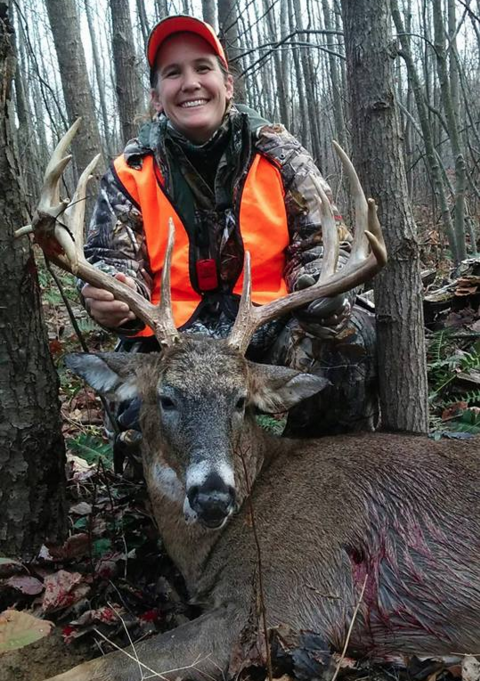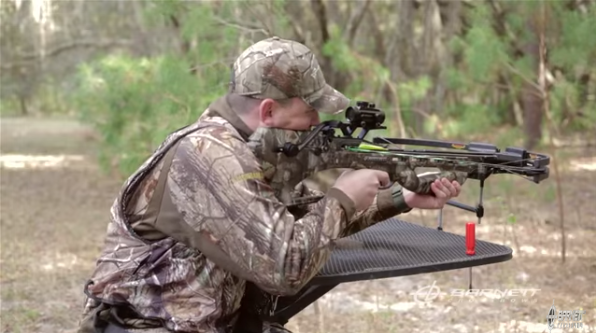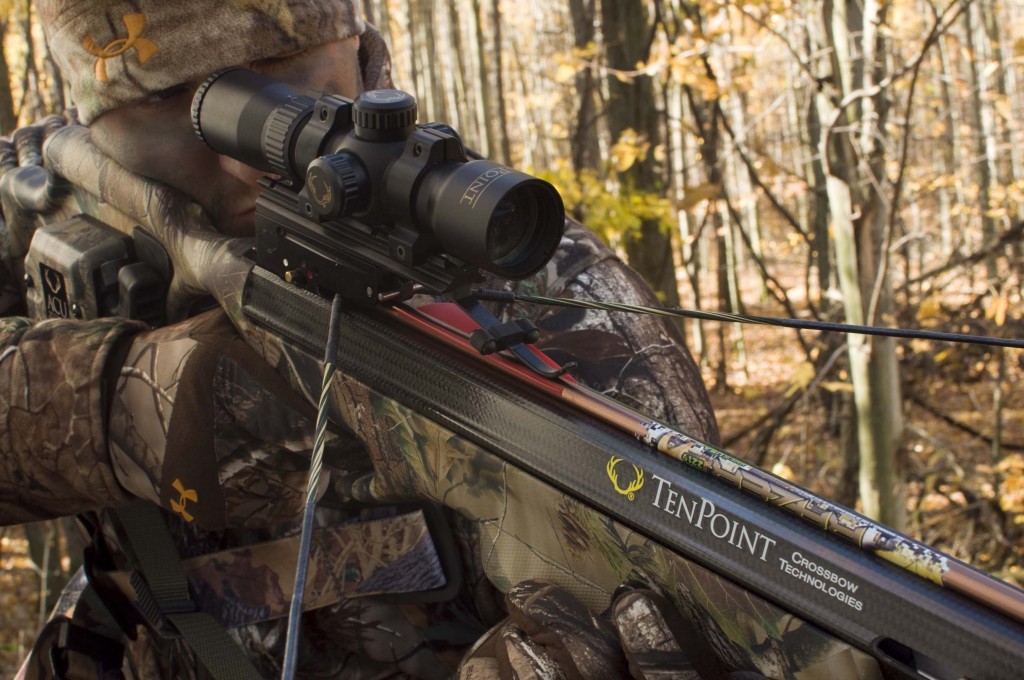Modern crossbows are highly efficient and accurate — amazingly so.
Most manufacturers pre-sight their crossbows at the factory before shipping them. When properly cocked with the right bolt and proper shooting mechanics, these crossbows produce consistent bull’s-eyes out of the box at 20, 30 and 40 yards. You might need to tweak them a little to get pinpoint accuracy or satisfy personal standards, but within recommended range limitations, dead-deer shots should be no problem.
By Al Raychard
We tend to forget, though, that crossbows — recurve or compound — are mechanical devices, and like all mechanical devices, they must be maintained. Parts and components wear and occasionally need to be replaced. Screws loosen, and scopes especially might have to be adjusted from time to time. In a nutshell, as high-tech and well-made as modern crossbows are, they require some attention for reliable accuracy and dependability — particularly before heading for the deer woods.
That’s especially true when the human factor enters the equation. Even top-of-the-line crossbows cannot do their job unless shooters do theirs. Because humans are, well, human, there is a lot of room for inconsistency or poor arrow strikes, even with a new bow. For achieving and maintaining consistent accuracy, most problems are human-based, and as a bow gets used and ages, the possibility of problems increases.
Several considerations can help you achieve and maintain consistent crossbow accuracy. Some involve the bow, but they all boil down to the shooter. Here are some factors that affect crossbow accuracy.
1. A Bow That Doesn’t Fit
Not all crossbows are of the same weight, length and width. Although there is a crossbow for everyone, there’s not a one-size-fits-all crossbow. There is a direct correlation between how well a crossbow fits you and accuracy. If a bow is too heavy, feels too long or wide, or is cumbersome to lift and hold on target, it doesn’t fit, and it’s not right for you.
Crossbows are built on rifle-like stocks, and like a rifle, they should not be overly burdensome, difficult to handle, or awkward or uncomfortable to use. Consider the length of pull to the trigger. Also, the trigger should be smooth and crisp, with little or no creep.
Bigger, heavier, faster and fancier is not always better, and that’s true when hunting with a crossbow and striving for consistent accuracy.
2. The Wrong Arrows
Whether you call them arrows or bolts, most crossbow makers recommend certain lengths and grain weights for various models. Some even recommend specific material — carbon or aluminum — and fletching length. Although most crossbows can shoot arrows with any type of nock, most manufacturers also recommend a specific type. That’s based on a model’s power stroke, draw weight, optimizing front of center and what works best to stabilize the arrow, as determined through extensive testing during the design and testing process.
To achieve maximize accuracy, you should only use arrows recommended by the manufacturer for a specific crossbow, and you should use those for sighting in and hunting every time. Changing or switching arrows will lead to trouble and inconsistent accuracy. It’s true lighter arrows fly faster, but remember that faster is not always better. You might best achieve ultimate arrow flight and overall control by using an arrow that flies at a slower or moderate speed, or at speeds recommended by the manufacturer. Using lighter arrows or arrows not recommended by the manufacturer can put added stress on the bow, increase the chance of injury and might void the manufacturer’s warranty.
Finally, give each arrow a spin test before using it, checking for straightness. Take a look at the arrow shaft. At today’s speeds and maximum recommended crossbow ranges, it makes little difference whether a shaft has a .001 or .005 straightness differential. At 40 yards, that’s a dead deer. But if the shaft is visibly bent, dented or otherwise damaged, get rid of it.

3. Loose-Fitting Components
It takes very little to throw a crossbow arrow off course. A few years ago, while hunting in Ohio, a nice buck entered my kill zone and gave me a broadside shot at 30 yards. I had driven all night, with the crossbow stowed in its case in the bed of my pickup. After arriving and grabbing a quick cup of coffee, I had immediately headed for the woods. I got the buck in my scope and shot, but instead of hitting the vitals, the bolt flew high, resulting in a clean miss. I couldn’t understand it. The bow had been dead on before I left home, and though the miss could have been caused by human error, I doubted it. After careful inspection, I noticed the scope had loosened. It apparently wasn’t fully secure at home, and it had loosened even more during the road trip. By taking for granted everything was tight — something I generally ensure via routine — I cost myself a nice buck. It’s a mistake I haven’t made since.
Today’s crossbows are extremely well built, but they vibrate during use, and through time, screws and bolts that hold the bow together are apt to loosen. Don’t repeat my mistake. Something as simple as one loose bolt or screw can affect accuracy. Make it a habit before going to the range or deer woods to ensure that all bolts, screws and nuts are tight. That includes the quiver, but especially bolts, screws and nuts that secure sights, the scope and the bow assembly where it attaches to the stock. In the process, look for worn, damaged or missing parts, and check the flight rail for nicks or anything that might influence arrow flight.
4. Improper Cocking Practices
To shoot straight every time, a crossbow must be cocked straight every time. When the bow is fully cocked and locked into position, the serving must be centered, with equal lengths on each side of the rail. If it’s off center by as little as 1/16 inch, the impact point can be off target left or right by several inches, depending on the range. The longer the range, the more it will be off mark. Typically, most people have more strength in one arm than the other, and during the cocking process, that dominant arm pulls the string easier and faster than the other, making it easy to get the string off center.
To help eliminate the problem, mark the serving with a felt pen or marker on each side of the rail when the string is at rest. During the cocking process, concentrate on what you’re doing, using the marks as a visual guide to help keep the string equal on each side of the rail right into the trigger housing.
Rope cocking devices, especially those with rail slides, and integrated cocking aids are a great help, too. Plus, they greatly reduce the physical effort needed to cock the bow.
5. Bow Not Properly Tuned
A crossbow must be properly tuned with a balanced brace height and balanced tiller.
Brace height is the distance between the bowstring and the belly side of the riser when measured from the string’s center when the bow is not cocked. If you put a mark on the side of the flight track where the string crosses, through time, you will notice the string will creep forward as it stretches. That’s normal, but as the string stretches and settles, arrow velocity changes, and arrow impact points will be higher or lower than in the past. To solve the problem, simply replace the string and, if necessary, the cables on compound models.
Tiller is the balance between the limbs, which should be identical in pull length and weight. It will become obvious the tiller is off balance if arrow impact points are scattered left or right on the target or when rail marks appear on the arrow shaft. In severe cases, the marks will appear heavy, especially along the nock end of the shaft.
To correct the problem, measure from where each limb meets the prod back to the string. They should be the same. Most compound models have an adjustment screw or bolt on each limb that can be turned in or out until both limbs, or the tiller, is the same. On recurve models, your only recourse is to replace the limbs. If you’re unsure in either case, consult an archery shop, or call the manufacturer.

6. Poor Maintenance
Many accuracy problems caused by loose components and poor tuning can be avoided with proper routine maintenance. Every new crossbow comes with an owner’s manual. Along with safety tips, assembly and sighting instructions, and other helpful and need-to-know information, the manuals contain a host of maintenance procedures.
Generally, at the top of the list, is something on the importance of lubricating the flight rail and waxing the string, except the server, and in some cases the cables. Some manufacturers also recommend checking for frayed strings and limb condition, and oiling the trigger box, axles on compound models and all bolts exposed to the weather.
Whatever the owner’s manual says, do it. By following the manufacturer’s maintenance recommendations, your string and other components should provide at least 150 to 200 shots, and the bow should provide years of reliable service.
7. Improper Shooting Practices
Shooters generally have several problems achieving consistent accuracy. The first is not holding the crossbow steady. Manufacturers have come a long way in reducing weight and making crossbows less cumbersome and awkward, but crossbows are still not the easiest things to hold on target, especially for long periods.

To increase accuracy when sighting in, always shoot from a bench, just as you would when sighting in a rifle. It will make the process much easier and simplify solving any accuracy problems. When hunting from elevated tree stands, use the safety rail to your advantage, if your stand has one. If not, shooting sticks or some other type of support aid will prove their worth.
The second consideration is firing the trigger. A crossbow trigger should be squeezed, not pulled. Pulling or jerking the trigger increases the chances of moving the bow during the shooting process and missing the shot. It takes very little movement to throw a crossbow arrow off mark, so using a shooting aid and squeezing the trigger are important for accuracy.
8. Not Lining it Up Properly
A major accuracy gremlin is cantering, or having one limb lower than the other when shooting. It is imperative to keep the limbs level, on the same plain or parallel with the ground. If the left limb is lower
There’s a direct correlation between how well a bow fits you and accuracy. If a bow feels too heavy, or seems too long or wide, it’s probably not right for you. If the left limb is lower than the right, the bow will shoot left. If the right limb is lower than the left, it will shoot right. And in either case, it will shoot high or low, depending on the range.
Eliminating this problem takes practice and concentration, which is not easy when a four-legged target is in range. However, it’s essential to maintain consistent crossbow accuracy.
9. The Right Scope
Scopes make target acquisition faster and easier, and they improve accuracy. But what constitutes a good crossbow scope? The answer depends on the shooter and the scope’s primary use: hunting or shooting targets. In either case, some basic parameters should be given priority.
Good light-gathering ability will prove its worth in low light, so something with a 1-inch tube and 32 mm optical lens is a good standard. Considering a crossbow’s short shooting range, high-powered magnification isn’t called for, but a 1- to 4X variable will help in faster target acquisition and pinpointing the vitals on game at close and maximum range. A wide field of view is also beneficial. A scope with adjustable parallax to 35 or 50 yards, or one that’s parallax-free to that range, will greatly improve accuracy and make your crossbow experience more enjoyable. And finally, any crossbow scope should compensate for arrow trajectory.

There are basically two types of popular crossbows scopes: multi-dot and multi-crosshair, most of which offer adjustable illumination. The multi-dot models work well for punching holes in targets and game, but at maximum range, the dots tend to obscure the target area. Even on the lowest setting in certain light conditions they seem to wash out the field of view.
Experienced crossbow hunters generally prefer multi-crosshair scopes. You can still see the crosshairs, whether they’re illuminated. Even if the battery dies you still can see them. Crosshairs make it easier to pinpoint shots to maximum range. The crosshairs can also be used in bracketing, or taking shots between ranges for which your crossbow is sighted. When mounted properly, they can be used to control or prevent canting the bow when shooting.
Whatever type of scope you use, proper mounting is essential to achieve and maintain accuracy. Consult the owner’s manual for instructions. If you’re unsure, have a gunsmith mount the scope for you.
10. Not Knowing Your Range
Manufacturers are pushing the limits of crossbow speeds and range, but 40 yards remain the industry’s maximum recommended range. Crossbow arrows will certainly fly farther, but doing so accurately every time — especially at game — is a different matter.
Knowing the range of your target is of the utmost importance to putting game down quickly and humanely. However, not every hunter can accurately estimate range, or at least not efficiently enough for pinpoint crossbow accuracy. A buck might be 25 yards away or maybe 35 — which is it? Those 10 yards can mean the difference between success and failure.
Know the distance you’re shooting. A quality rangefinder should be considered a vital part of every crossbow hunter’s arsenal, and should be used at the range for sighting in and marking the distance to trees, stumps and other objects from your stand or blind. When a buck works past that mark, you will know exactly how far it is and which crosshair to use.
— PAID PARTNER CONTENT. This content is brought to you by a D&DH advertising sponsor.


